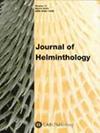Spatial distribution and coexistence of monogenean gill parasites inhabiting two damselfishes from Moorea island in French Polynesia
IF 1.3
3区 生物学
Q4 PARASITOLOGY
引用次数: 0
Abstract
The ectoparasite fauna of two damselfishes,法属波利尼西亚穆雷阿岛两种豆娘鳃寄生虫的空间分布和共存情况
研究了法属波利尼西亚穆雷阿岛的两种豆娘(Stegastes nigricans 和 Dascyllus aruanus)的体外寄生虫群。这些豆娘的鳃感染了属于 Haliotrema 属的同科 Monopisthocotylea Monogenea。发现 Stegastes nigricans 中栖息着三个 Haliotrema 种类,而 D. aruanus 中只栖息着一个种类。研究了微生境分布、种间和种内竞争以及鳃上的种间关联。对栖息地偏好的观察表明,栖息在 S. nigricans 鳃上的三个同属物种之间没有空间隔离。该类群的幼鱼和成鱼在同一微生境中栖息。当感染强度增加时,优势种 Haliotrema sp.种间关联测试显示了正负关联。当感染强度增加时,Haliotrema sp. 4 在 Dascyllus aruanus 的鳃上的分布范围扩大,这表明可能存在种内竞争。由于种内竞争,Haliotrema sp. 4 的幼虫和成虫似乎出现了分离。当鳃栖息地有限时,这种竞争可能是为了提高资源的可用性。栖息于 S. nigricans 的单基因物种的生态位广度和物种微生境之间存在重叠。种间竞争在黑线鲃同属外寄生虫的分布中似乎并不重要。生殖障碍的加强可能导致了杂交的避免。
本文章由计算机程序翻译,如有差异,请以英文原文为准。
求助全文
约1分钟内获得全文
求助全文
来源期刊

Journal of Helminthology
生物-动物学
CiteScore
2.80
自引率
12.50%
发文量
127
审稿时长
3 months
期刊介绍:
Journal of Helminthology publishes original papers and review articles on all aspects of pure and applied helminthology, particularly those helminth parasites of environmental health, medical or veterinary importance. Research papers on helminths in wildlife hosts, including plant and insect parasites, are also published along with taxonomic papers contributing to the systematics of a group. The journal will be of interest to academics and researchers involved in the fields of human and veterinary parasitology, public health, microbiology, ecology and biochemistry.
 求助内容:
求助内容: 应助结果提醒方式:
应助结果提醒方式:


